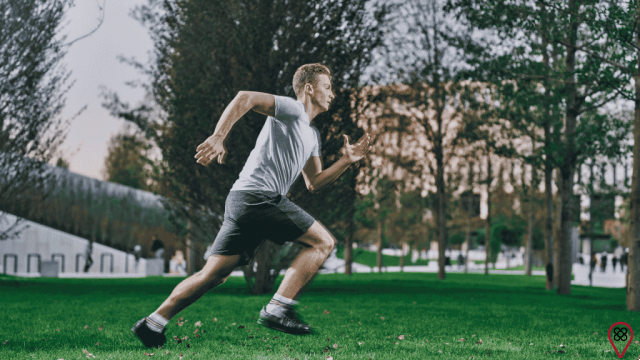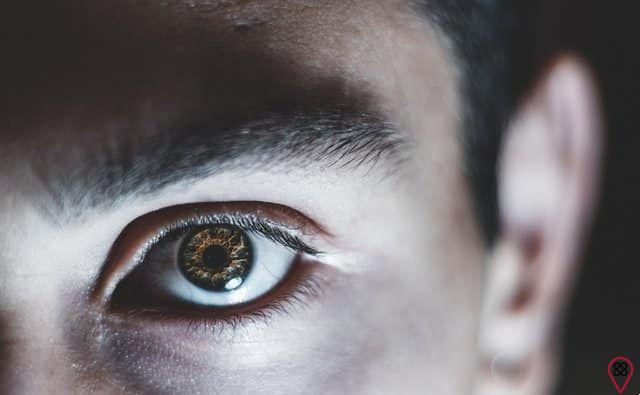Everyone has felt that butterflies in their stomach before a long-awaited or too important event. That feeling that even causes a certain good expectation. Or, less positively speaking, we have all experienced intense stress too, capable of triggering a stress response in the body.
In both cases, reacting like this is considered absolutely normal, being the result of a defense mechanism that comes into action so that we flee or face a potential threat or challenge. It's what we call "good" anxiety or the famous nervousness, which is a temporary condition and resolves as soon as the stress is gone.
Anxiety is part of our behavior and is acceptable and even necessary. If experienced in a healthy and functional way, by keeping us attentive and helping us to face and solve various day-to-day issues, it drives us to evolve and adapt.
The problem is when this reaction is exacerbated, when the fear and reaction are disproportionate or occur without any concrete situation actually putting us at real risk. It's called generalized anxiety disorder (GAD), which we'll delve into in this article.
What is Generalized Anxiety Disorder (GAD)?
GAD is a disorder that is characterized by excessive worry and apprehensive expectation that is not temporary and difficult to manage. It is a disease classified by the Manual of Classification of Mental Illnesses, being one of the five types of anxiety disorders cataloged by doctors.
For as long as humanity has existed, anxiety has been part of our daily lives. From the times when we hunted or gathered food – living under the threat of predators and enemies or food shortages – through invasions by other peoples, urbanization and population explosion, to the concerns of the modern world.
Although the idea that talking about anxiety is talking about the history of humanity, the term “anxiety” in the sense of illness only began to be used in the early 1808th century, even before talking about “Psychiatry” (which only emerged more later, in XNUMX), but it was a condition considered “nerve disease” (hence the term “neurosis”), dissociated from the mental state, a fact that only came to be considered in the early years of the XNUMXth century.

What we can understand about anxiety disorder is that, even though we are no longer in the reality of the dangers that our ancestors experienced, it is still worth noting that the triggers for anxiety do not come only from potential risks - be they concrete, or projections of life. bad or apprehensive odds. Nowadays, the stimuli to which we are exposed are many and constant – social networks are present to corroborate this.
The effects of pathological anxiety can be devastating in all aspects, as it can cause a number of harmful events in the body – such as overloading the heart, raising blood pressure, causing problems such as acne, headaches and skin allergies.
And, because it is a persistent and difficult to control disease, anxiety undermines a person's quality of life. It can even be downright disabling, given the cognitive impairments it causes. We will see later on the symptoms and complications that this disease brings to the lives of those affected.
Causes and symptoms of generalized anxiety disorder (GAD)
According to 2019 data from the World Health Organization (WHO), in Spain alone there are more than 18 million people suffering from some type of anxiety disorder, a number that makes España the world champion of the disease.
Each person is a person and emotional disorders are closely related to the particularity of each one, however we can highlight here some of the main causes, or better defined, risk factors for generalized anxiety disorder:
- genetics;
- Gender (women are the most affected);
- Traumatic events that occurred in childhood – also in adolescence and even in adulthood (such as serious illness, environmental stress, family violence, psychological abuse, among others);
- External problems such as financial insecurity, job loss, separation, bereavement, assault, etc.;
- Substance abuse such as alcohol, caffeine, some drugs and tobacco;
- Medical conditions, such as side effects of some medications or thyroid disease, for example;
As we have seen above, the TAG numbers in España are considerable, so it is not uncommon for you to have already come across an anxious person – or even you are that person – so you must already know some of the most common symptoms of the disorder. Even more so if we analyze the years 2020 and 2021, due to the height of the Covid-19 pandemic and its effects on the emotions of people around the world.
Anxiety is usually associated with other mental illnesses, such as depression. And identifying symptoms as anxiety can be complex, as there are anxiety symptoms, which are not the disorder itself. In addition, most of them are also associated with other physical diseases – such as dizziness, nausea, shortness of breath and rapid heartbeat, which can be related to other diseases.
That is why it is essential to be up to date with physical exams and, in the most frequent occurrence of symptoms associated with anxiety (which we will list later), it is necessary to seek medical help. Only the specialized professional - such as the psychiatrist or psychologist - can close the diagnosis of this disease.
In any case, among the most common symptoms of generalized anxiety disorder, we can highlight the following:
Physical symptoms:
- excessive sweating;
- shortness of breath and/or hyperventilation (breathing);
- heat waves;
- chills and tremors;
- chest pain, which may accompany tachycardia (rapid heartbeat);
- dizziness or vertigo, and there may be a feeling of imminent fainting;
- nausea or “butterflies in the stomach”;
- muscle tension or pain;
- headache;
- changes in vision, which may come with eye twitching;
- tearing or dryness of the eyes;
- frequent urination and/or stomach pain;
As it is a disease that also has specific aspects, there may be other symptoms typical of each one, but, as we have already said, a detailed medical consultation is essential to rule out any other disease that may share the same signs.
Psychological, cognitive and social symptoms:
- inexplicable fear;
- intrusive thoughts (which may involve worries about misfortunes, catastrophes, death, illness, job loss, among others);
- mood swings, irritability and restlessness;
- insomnia;
- difficulty concentrating and memory problems;
- feeling that you are dreaming, as if you are not in your own body;
- difficulty initiating and maintaining a conversation;
- excessive concern with the opinion of others;
- fear of displeasing, leading to not knowing how to say no;
- predominantly pessimistic view;
- blocking and stoppage;
- motor hyperactivity;
- habit of biting one or the other that also works as an exhaust valve.
There are several other symptoms, such as physical ones, which may also vary according to each person. It is also important here to seek a conclusive diagnosis, so that there is no confusion with other mental illnesses, such as bipolar disorder.
A study published in July 2020 by the University of Trento (Italy) in the journal Scientific Reports, of the scientific journal Nature, mapped how different types of anxiety impact each area of the brain. The researchers came to the conclusion that there are two forms of manifestation: state anxiety (arising from stressful events) and trait anxiety (referring to naturally anxious people).
The purpose of this study was to better understand how the mechanism of the disease works and seek targeted treatments that can specifically address each problem. These findings may also enable a more accurate diagnosis and a more efficient treatment, even aiming to alleviate the symptoms of this disorder before they become chronic.
Ways to manage anxiety and treatment
As we have already explained throughout this article, it is essential to look for a doctor to make the correct diagnosis, based on a careful clinical evaluation and, if necessary, the performance of medical exams.

Consultation with the specialized professional is necessary for you to know if you really suffer from this disorder or not. Or, even, if you do not suffer from any other psychic disorder, which will obviously require different behaviors and treatments.
Once the disorder has been correctly diagnosed, treatment begins, which usually may combine the following processes:
- Medication: there is a specific class for the treatment of anxiety, but only the doctor is able to identify and prescribe it. And this is due to a number of reasons. First, these drugs have serious side effects. Also, some of them take a while to show results. And, finally, if it doesn't work out and you quit on your own, you could run into problems, as weaning – as drug withdrawal is called – can cause negative reactions. And medical follow-up is essential at all these stages. Therefore, no taking medicine tips from a friend, relative, or self-medication!
- Psychotherapy: as important as medication, psychotherapy is essential to help us understand and deal with our emotions, reorganizing and preparing the mind to deal with thoughts, feelings, triggers and situations in which the crisis is triggered. The psychologist and psychiatrist are the appropriate professionals in this process.
It is worth mentioning that the psychologist cannot prescribe any type of medication, as only the doctor has this prerogative. In this case, between the two mentioned here, only the psychiatrist can prescribe medication.
Well, the first step has already been taken, so it's time to look for ways to minimize the impact of anxiety in your life, such as physical activity. We all know that moving the body is a way to maintain a healthy life in general – the WHO, for example, recommends at least 150 minutes a week of moderate exercise.

To add to the list of benefits of this practice, there is no shortage of studies that prove that it can not only minimize the symptoms of anxiety but also prevent its emergence. And research published in the journal Frontiers in Psychiatry in September 2021 revealed that regular exercise can reduce the risk of developing this disorder by up to 60%.
And moving the body doesn't mean being in a gym or at home lifting some weight. Of course, there are certain physical activities that can have a more efficient impact on the problem, but the important thing is not to stand still, as moving helps produce a series of good hormones, including for emotions, providing well-being.
Speaking of well-being, it is also possible to insert other practices into your daily life to help control or at least minimize the symptoms of anxiety, such as:
- Do meditation;
- Listen to music;
- Practice mindfulness, or mindfulness;
- Practice yoga;
- Dedicate part of the day to taking care of yourself;
- Adopt healthy habits, such as sleeping properly, eating well and drinking plenty of water;
- Learn to understand feelings;
- Don't focus on hypotheses or possibilities - what didn't happen, didn't happen. You have to worry about the here and now;
- Knowing your own limits and learning to practice self-respect;
- Learning to say “no”;
There are a number of other actions that you can take in this search for the balance of emotions, but remember that there is no way to self-diagnose yourself with generalized anxiety disorder and most importantly: do not self-medicate, nor "try" that medication that it worked for a friend, a co-worker, a relative, because only the doctor can medicate.
You may also like
- Tips to alleviate anxiety
- Foods that help with anxiety
- Try these yoga poses to calm your mind
If you are experiencing this problem and you still don't have a diagnosis, look for your doctor, so that you can be guided in the proper way. Anxiety as a disorder can be scary most of the time, but it is treatable and you can overcome this challenge with the proper help. In addition, it is up to you to seek this help and continue to seek balance and to bring your life to the point where it was before this unwanted “guest” arrived.

























